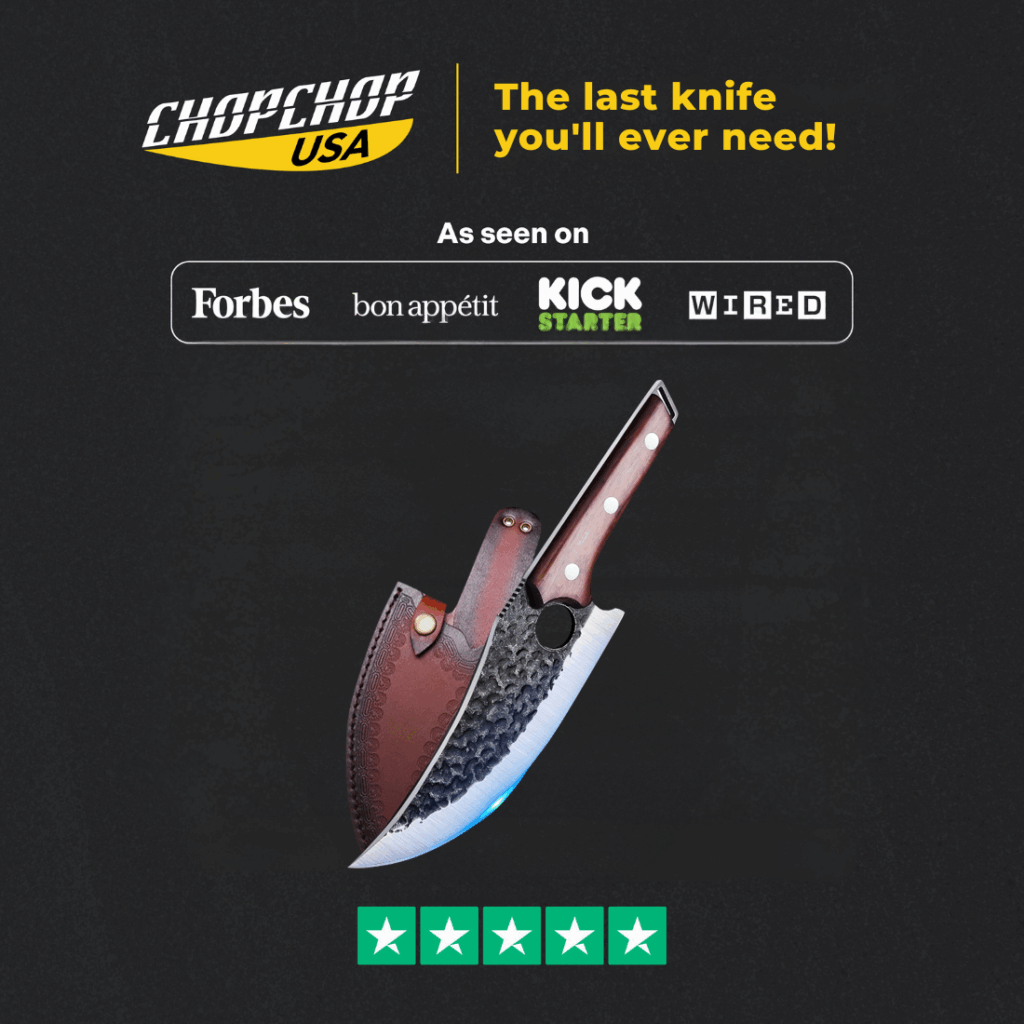Cutting boards are essential in every kitchen, and wooden cutting boards have long been a favorite for their rustic charm, durability, and knife-friendly surface. Loved by home cooks and professionals alike, they offer both function and beauty. But are they right for everyone? Despite their strengths, wooden boards require maintenance and raise hygiene concerns.
In this blog, we’ll break down the pros and cons of wooden cutting boards and compare them to modern titanium cutting boards, like those from ChopChop USA. Whether you value tradition or want a cleaner, low-maintenance option, this guide will help you choose the best cutting board.
Pros of Wooden Cutting Boards
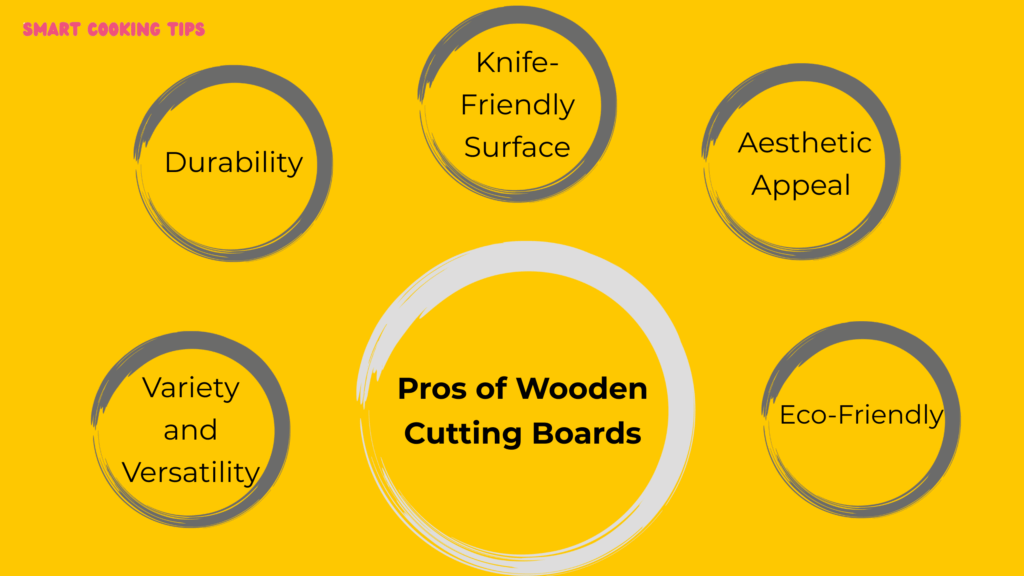
1. Variety and Versatility
One of the biggest draws of wooden cutting boards is the variety they offer. You’ll find them in an array of shapes, sizes, and thicknesses. Whether you prefer a sleek, minimalist design or a thick, butcher-block style, there’s a wooden board to suit every aesthetic and cooking need.
Unlike bamboo boards, which are often made from glued-together strips, wooden cutting boards can be constructed from solid pieces or laminated hardwoods, providing both visual appeal and structural strength.
2. Durability
High-quality wooden cutting boards are built to last. Hardwoods like maple, walnut, and cherry are naturally dense and can withstand years of chopping, slicing, and dicing. With proper care—including regular oiling and gentle cleaning—these boards can outlive their plastic or glass counterparts.
Wood has the unique ability to “self-heal” shallow knife marks over time, which helps the board maintain its appearance and structure even after repeated use.
3. Knife-Friendly Surface
One of the biggest reasons chefs and home cooks love wooden cutting boards is their knife-friendly surface. Unlike harder materials such as glass, ceramic, or even some rigid plastics, wood has a slight natural give that cushions each cut. This softness reduces the impact on your knife’s edge, helping to prevent dulling over time. As a result, your knives stay sharper longer, saving you time and money on frequent sharpening.
4. Aesthetic Appeal
Let’s face it—wooden cutting boards are undeniably beautiful. With rich, warm tones and unique grain patterns, they add a natural, timeless charm to any kitchen. Whether you’re preparing a meal or displaying food, these boards elevate your presentation. Many wooden boards are so attractive and well-crafted that they’re used as serving trays for cheese, charcuterie, or artisanal bread, blending functionality with rustic, elegant style that impresses guests and complements any décor.
5. Eco-Friendly
Many wooden cutting boards are crafted from sustainably harvested wood, making them a more eco-friendly choice than plastic alternatives. Wood is a renewable, biodegradable material that naturally decomposes over time without harming the environment. It’s also free from synthetic chemicals commonly found in plastic boards. When properly sourced and maintained, a wooden cutting board offers a balance of practicality, longevity, and environmental responsibility, making it a smart, sustainable option for conscious cooks.
Cons of Wooden Cutting Boards
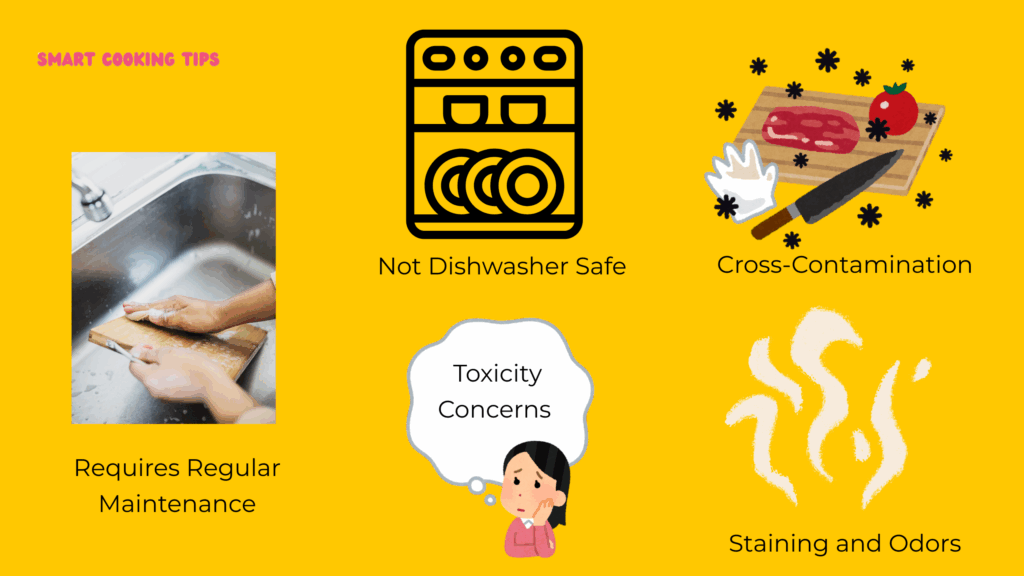
1. Requires Regular Maintenance
While wooden cutting boards are durable, they need regular maintenance to stay in good condition. Applying food-grade mineral oil routinely prevents the wood from drying out, cracking, or warping. Without this care, the board’s surface can become damaged and less effective for safe food preparation. Proper upkeep extends the board’s lifespan, keeps it looking great, and maintains its functionality in the kitchen.
2. Not Dishwasher Safe
One major drawback of wooden cutting boards is that they aren’t dishwasher-safe. The high heat and prolonged moisture exposure in dishwashers can cause the wood to swell, crack, or warp over time. To maintain their durability and shape, wooden boards must be hand washed with mild soap and thoroughly dried immediately after use. Proper care is essential to preserve their quality and longevity in the kitchen.
3. Potential for Cross-Contamination
Wood’s natural porosity means bacteria can seep into the surface if not cleaned properly. Knife grooves can trap food particles, increasing the risk of contamination. It’s crucial to thoroughly wash and sanitize wooden cutting boards after handling raw meat, poultry, or fish to prevent bacterial growth and cross-contamination. Proper cleaning ensures your board remains safe and hygienic for everyday kitchen use.
4. Staining and Odors
Certain foods such as beets, turmeric, and garlic can leave stubborn stains and strong odors on wooden cutting boards. Lighter woods like beech are especially prone to discoloration. To remove these stains and smells, scrubbing with natural remedies like lemon and salt or using a deep cleaning method with baking soda is often necessary. Proper cleaning helps maintain the board’s appearance and freshness over time.
5. Toxicity Concerns
Not all wood is safe for food preparation. Some exotic hardwoods contain natural oils or toxins that may leach harmful substances into your food. To ensure safety, opt for cutting boards made from food-grade woods such as maple, walnut, or cherry. Always confirm that the board is untreated and specifically designed for food contact to avoid potential health risks and ensure a safe, durable kitchen tool.
Wood vs. Titanium Cutting Boards: Full Comparison
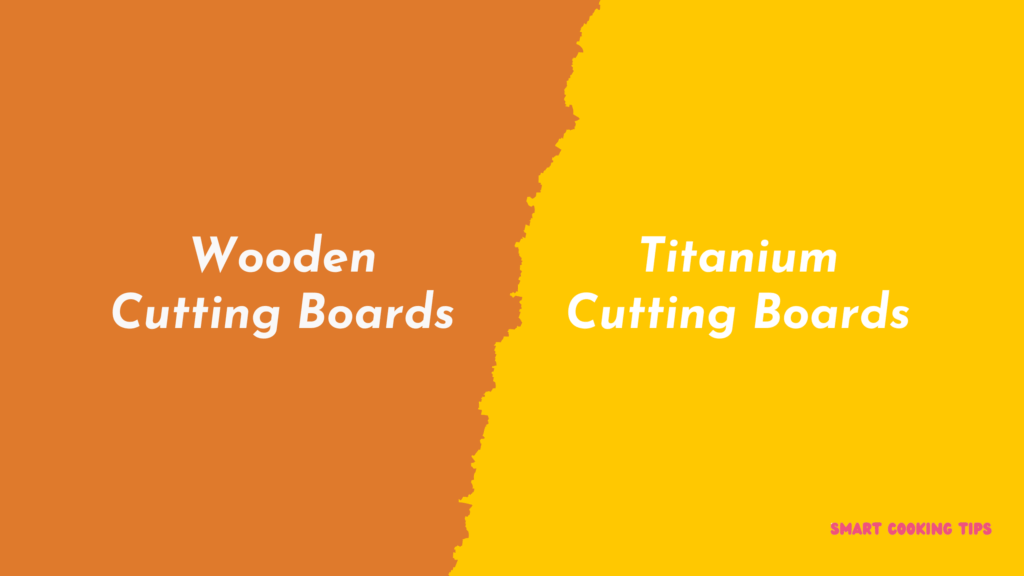
With advancements in kitchen technology, titanium cutting boards are gaining attention as a modern alternative to wood. Titanium cutting boards that offer impressive performance, especially for those seeking hygiene and convenience.
Let’s compare wooden cutting boards and titanium boards side-by-side.
| Feature | Wooden Boards | Titanium Boards |
| Durability | Long-lasting with maintenance | Ultra-durable and scratch-resistant |
| Hygiene | Porous, needs careful cleaning | Non-porous, naturally bacteria-resistant |
| Maintenance | Needs oiling and hand washing | Dishwasher-safe, low maintenance |
| Knife-Friendliness | Very gentle on blades | Harder surface but still gentle on blades |
| Eco Impact | Renewable, biodegradable | Recyclable, long-lasting (low waste) |
| Design Appeal | Rustic, traditional charm | Sleek, modern innovation |
Wooden cutting boards are perfect for cooks who appreciate traditional craftsmanship and don’t mind the extra care they require. They offer knife-friendliness and a classic look that many find irreplaceable.
Titanium cutting boards cater to a more modern kitchen lifestyle. They’re ultra-hygienic, practically indestructible, and require minimal upkeep—ideal for busy families and serious foodies alike.
Spotlight: ChopChop USA Titanium Cutting Boards
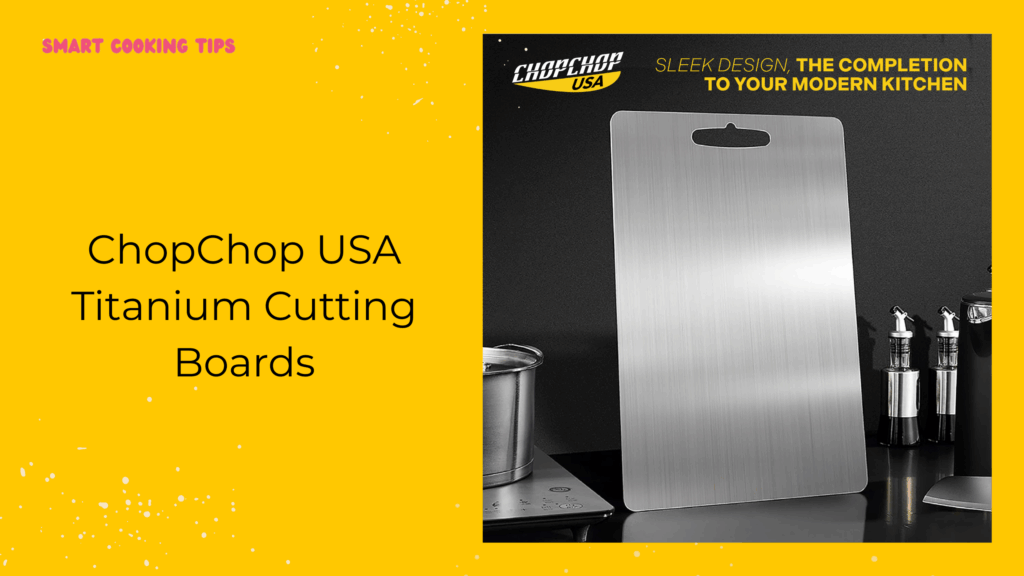
Why Titanium?
Titanium is a premium, non-toxic, and food-safe metal known for its exceptional resistance to bacteria, corrosion, and odors. Leveraging these superior qualities, ChopChop USA has engineered cutting boards that not only perform flawlessly but also elevate kitchen hygiene and durability far beyond traditional materials.
Standout Features
- Scratch-resistant surface: The titanium surface resists scratches and cuts, maintaining a smooth, flawless finish even after extensive use. This durability keeps the board looking new and professional for years without wear or tear.
- Naturally antimicrobial and easy to sanitize: Titanium naturally inhibits bacterial growth, making the cutting board safer for food prep. Its smooth, non-porous surface cleans quickly and thoroughly, ensuring excellent hygiene with minimal effort.
- Dishwasher-safe and heat-resistant: Unlike wood, ChopChop USA titanium boards can be safely cleaned in the dishwasher, saving time and effort. They also withstand high temperatures without warping or damage, perfect for busy kitchens.
- Sleek, futuristic design: With a minimalist, modern aesthetic, these boards enhance any kitchen décor. Their sleek lines and metallic finish blend innovation with style, making them both functional tools and eye-catching kitchen accessories.
- Lightweight yet strong: Despite titanium’s strength, these cutting boards are surprisingly lightweight, making them easy to handle and store. Their sturdy construction resists bending or cracking, combining convenience with unmatched durability.
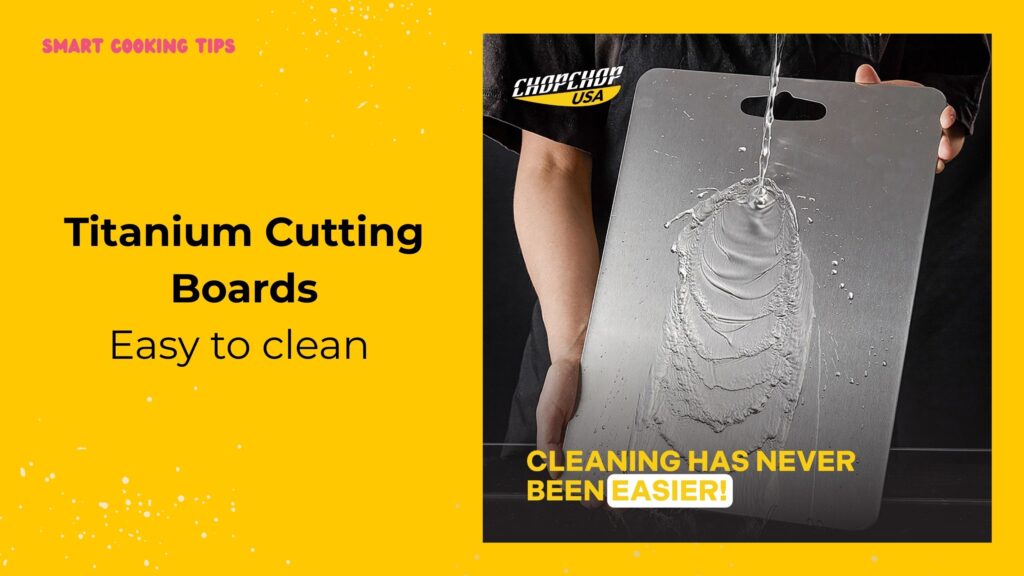
ChopChop™ USA
100% Pure Titanium Cutting Board
ChopChop™ USA
Boning Knife
Perfect For
ChopChop USA titanium cutting boards are perfect for home chefs seeking professional-quality tools that combine high performance with easy maintenance. They’re also ideal for those who prioritize food safety, hygiene, and want to avoid the frequent upkeep required by wooden boards.
Eco-Conscious Choice
Unlike plastic cutting boards that degrade or wooden boards that require regular replacement, ChopChop’s titanium boards are built to last for decades. They are 100% recyclable, making them an environmentally responsible choice that reduces waste and promotes sustainable kitchen practices.
Conclusion
Wooden cutting boards offer warmth, durability, and knife-friendly surfaces—perfect for traditionalists who value craftsmanship and don’t mind routine care. However, their need for maintenance and potential hygiene issues may not suit everyone.
If you prefer a low-maintenance, ultra-hygienic option, titanium cutting boards from ChopChop USA are a smart upgrade. Whether you value rustic charm or modern convenience, choose the cutting board that fits your kitchen habits and lifestyle.
Assess your kitchen habits and pick the board that best matches your lifestyle.
FAQs
1. Are wooden cutting boards sanitary?
Yes, when properly cleaned and maintained. Wood has natural antimicrobial properties but still requires regular sanitation.
2. What wood is best for cutting boards?
Maple, walnut, cherry, and teak are popular food-safe choices for wooden cutting boards.
3. How often should you oil a wooden cutting board?
It’s best to oil it every 3–4 weeks or whenever the wood looks dry.
4. Can you put wood cutting boards in the dishwasher?
No. Dishwashers can damage wooden cutting boards due to heat and moisture.
5. Is titanium safe for food prep?
Absolutely. Titanium is non-toxic, corrosion-resistant, and ideal for food contact.
6. What makes ChopChop USA’s titanium board different?
Their boards are designed for both performance and hygiene, with antimicrobial surfaces, sleek design, and unmatched durability.





